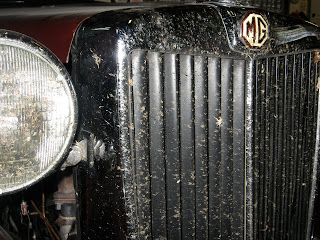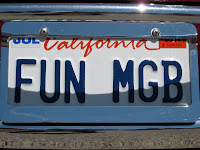 Having completed the Rallye to Reno leaving my companion in Dodge City, I flew back to Detroit on Friday, June 16th. With neither the TD here to diagnose nor the disassembled MG Midget race car motor available to work on, "retirement" became a challenge within a few hours. Sensing an opportunity, Carol and I decided to trailer a load of beds and furniture to our son, Lukas and spend a week with him and his partner, Cara, on their organic farm in the upper Hudson River valley. This solved the "retirement problem" as farm work begins about 5:30 AM and does not end until about 8:00 PM, Monday through Sunday-- makes no never-mind. Chain sawing tree limbs and trying to diagnose a couple of problems on their big green John Deere 2750 was the "rest break." The rest of the time was spent on all fours out in the field either hand weeding, thinning vegetables, or transplanting seedlings for the late season crops of squash, beets, tomatoes. Then the phone rang. Saved by the bell!
Having completed the Rallye to Reno leaving my companion in Dodge City, I flew back to Detroit on Friday, June 16th. With neither the TD here to diagnose nor the disassembled MG Midget race car motor available to work on, "retirement" became a challenge within a few hours. Sensing an opportunity, Carol and I decided to trailer a load of beds and furniture to our son, Lukas and spend a week with him and his partner, Cara, on their organic farm in the upper Hudson River valley. This solved the "retirement problem" as farm work begins about 5:30 AM and does not end until about 8:00 PM, Monday through Sunday-- makes no never-mind. Chain sawing tree limbs and trying to diagnose a couple of problems on their big green John Deere 2750 was the "rest break." The rest of the time was spent on all fours out in the field either hand weeding, thinning vegetables, or transplanting seedlings for the late season crops of squash, beets, tomatoes. Then the phone rang. Saved by the bell! |
| With Cara at Quincy Farm, Easton, NY |
Jenny from Sancrest Specialized Transportation was informing me that on Monday the 27th I could expect delivery of my "parcel." My back and knees thanked her and we hurried home, arriving late Sunday night after a 14-hour haul. The next day, a friendly young fellow from Milan, MI pulled his Dodge diesel and trailer into the Chelsea High School parking lot and we unloaded Morris and the little CombiCamper trailer I had been pulling. The car started right up, ran perfectly...except for that loud metallic valve train sound. And bugs.
2,800 miles worth of dead bugs!
So, the MG Drive for CURE is completed. What started as a singular adventure became an exercise in the unexpected, a chance to meet a lot of kind and generous people, and a unique opportunity to experience better luck than I could ever have imagined having.
I set out to drive a 59-year old British car across the country, had to replace a few parts that succumbed to 106-degree Kansas heat-- and actually had those parts packed as spares, was confronted with a problematic engine sound in the far reaches of western Kansas, and chose to leave the car behind rather than risk a catastrophic failure crossing the Rockies or the Nevada desert.
Luck?? You bet!
Between Louisville, Kentucky and the Rocky Mountains in Colorado I am acquainted with exactly one person-- a man I have only known from a car-related internet community called "Spridgets at Team.net." Jim Johnson, a retired meteorologist, long-distance motorcyclist, and MG car guy, lives exactly six blocks from the hotel parking lot where I decided part ways with Morris. He not only gave me the keys to his truck so I wouldn't be stranded, he managed to get Morris stored in a Dodge City Civil Defense tornado shelter for as long as I needed. "Safest place in Dodge City," he quipped, "Two-foot thick concrete all the way around." One rally participant from New Jersey is in the limousine business and provided me the name of a transport company he uses out of Missouri. Another, Steve Rybicki, informed me he owns a trucking company in Springport, MI, about 50 miles from my home, and could try to help out. I call that a pretty fortunate day in Dodge City!
It's good when you can notice apparently good karma unfolding. And that day in Dodge City was my opportunity.
Then Dick Lunney from Charlotte, SC, editor of Classic MG Magazine, offered me his passenger seat to Grand Junction where his wife was flying in. Then PJ Lenihan from Winston-Salem, NC gave me his keys to have fun until his wife showed up by plane in Reno. Then George Kress and his red MGA from Pittsburgh took me in and later Jerry Morris from Owego, NY and Vincent Louie from California. None of these people knew me from Adam. But all extended a friendly hand.
Finally, the MG Drive for CURE was envisioned as a way to inspire the generosity of others for a cause I feel strongly about. It far exceeded my expectations in that regard and I am forever grateful to the friends, relatives, corporate sponsors and total strangers who chose to make charitable contributions to the CURE Childhood Cancer organization by way of the FirstGiving site www.tinyurl.com/mgdrive.
Over $5,000 has been donated and I'm thrilled to have been a catalyst for this cause. Thank you so very much!
Now, I understand old US Rte 6 is mostly 2-lane from Massachusetts to California. Where did I leave the keys to my '63 VW Beetle?
John Deikis
 |
| Back in Chelsea...at last! |
 |
| Car haulers were not designed for Little British Cars |
 |
| They gave their lives so others might party |
 |
| Morris will ride again! |














































